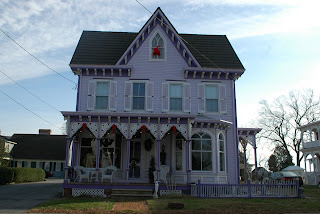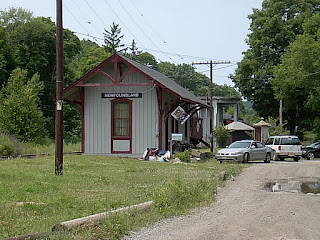Under the aegis of the U.S. Department of the Interior Subsistence Homesteads program, nearly two square miles of Monmouth County farmland became an agricultural and industrial cooperative community for unemployed Jewish garment workers seeking to leave overcrowded Manhattan living conditions. Russian immigrant and community founder Benjamin Brown envisioned a place where Jewish culture would be preserved. In fact, the records of many of the early town meetings were kept in Yiddish.
Like many other planned communities, Jersey Homesteads was laid out functionally, with clusters of houses on half acre lots, surrounded by common open space. All were designed in the Bauhaus style that was in the vogue in Europe at the time: single story concrete-and-steel buildings with little if any ornamentation. You can imagine that these living quarters were quite different from what the Homesteads residents were accustomed to on the Lower East Side.
The farm experiment didn't work out too well, as most of the settlers had little experience working the land, and the collectively owned and operated garment factory ultimately met a similar fate. However, the community became a haven for artists and intellectuals from the very beginning. Noted artist Ben Shahn moved to town in 1937 and left his mark most notably with a huge fresco mural in the Roosevelt public school building, depicting immigration history and labor reforms. These days, artists and non-polluting businesses occupy the old factory, and Roosevelt's population is one of the most highly educated in the state.
 On my visit one Saturday, Roosevelt was quiet, leaving me to drive around town slowly to get a glimpse of what had become of the original structures and town design. What I saw was a mix of the old Bauhaus along with some more recent construction, all pretty much remaining in the envisioned peaceful environment.
On my visit one Saturday, Roosevelt was quiet, leaving me to drive around town slowly to get a glimpse of what had become of the original structures and town design. What I saw was a mix of the old Bauhaus along with some more recent construction, all pretty much remaining in the envisioned peaceful environment.The public buildings are all basically gathered in the same place: the post office, deli and grade school are clustered on one street, while town hall is just down the road. I stopped by the school to see if I could get a glimpse of the Shahn mural, but it was out of view. What I found instead was both fascinating and a little weird.
There's a small outdoor amphitheater next to the school, with a prominent bust of Franklin Delano Roosevelt. Actually, it's not a bust in the traditional sense. It's more like a Roosevelt head mounted on a square column on which his name is chiseled. It's a decent enough likeness, but there's something about it that seems, well, kinda weird. Surrounded by benches as it is, and bereft of an actual body (which, given the size of the head would be darn imposing), it's almost supernatural, as if there's one night of the year when people gather to receive messages from it or something. That's not to say that there's anything strange going on there. It just struck me odd.
Read the town's website or talk to any of its residents, and it becomes very clear that this is a close-knit community with a civic consciousness and pride in its origins. The homes may be modest and the amenities in town are very limited, but Roosevelt remains a desired address for cultured types. Just remember that you have to pick up your mail at the post office.




























